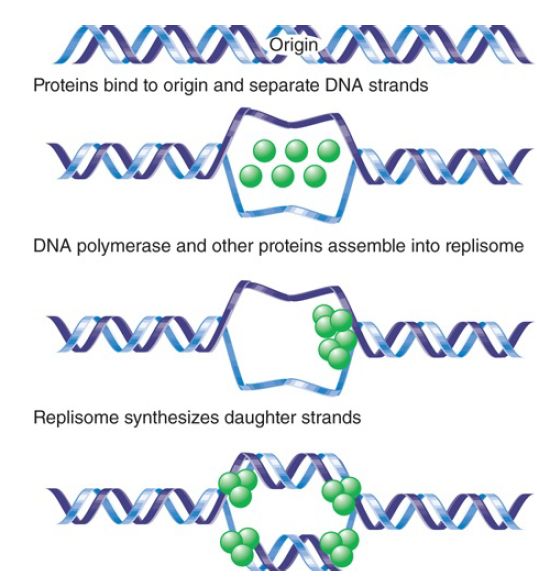
Introduction to the DNA Replication
 المؤلف:
Introduction to the DNA Replication
المؤلف:
Introduction to the DNA Replication
 المصدر:
LEWIN’S GENES XII
المصدر:
LEWIN’S GENES XII
 الجزء والصفحة:
الجزء والصفحة:
 4-4-2021
4-4-2021
 2053
2053
Introduction to the DNA Replication
Replication of duplex DNA is a complicated endeavor involving multiple enzyme complexes. Different activities are involved in the stages of initiation, elongation, and termination. Before initiation can occur, however, the supercoiled chromosome must be relaxed . This occurs in segments beginning with the replication origin region. This alteration to the structure of the chromosome is accomplished by the enzyme topoisomerase.
Replication cannot occur on supercoiled DNA, only the relaxed form. FIGURE .1 shows an overview of the first stages of the process.
- Initiation involves recognition of an origin by a complex of proteins. Before DNA synthesis begins, the parental strands must be separated and (transiently) stabilized in the singlestranded state, creating a replication bubble. After this stage, synthesis of daughter strands can be initiated at the replication fork .
- Elongation is undertaken by another complex of proteins. The replisome exists only as a protein complex associated with the particular structure that DNA takes at the replication fork. It does not exist as an independent unit (e.g., analogous to the ribosome), but assembles de novo at the origin for each replication cycle. As the replisome moves along DNA, the parental strands unwind and daughter strands are synthesized.
- At the end of the replicon, joining and/or termination reactions are necessary. Following termination, the duplicate chromosomes must be separated from one another, which requires manipulation of higher-order DNA structure.

FIGURE .1 Replication initiates when a protein complex binds to the origin and melts the DNA there. Then the components of the replisome, including DNA polymerase, assemble. The replisome moves along DNA, synthesizing both new strands.
Inability to replicate DNA is fatal for a growing cell. Mutants for replication must therefore be obtained as conditional lethals. These are able to accomplish replication under permissive conditions (typically provided by the normal temperature of incubation), but they are defective under nonpermissive, or restrictive, conditions (provided by the higher temperature of 42°C). A comprehensive series of such temperature-sensitive mutants in Escherichia coli identifies a set of loci called the dna genes. The dna mutants distinguish two stages of replication by their behavior when the temperature is raised:
- The members of the major class of quick-stop mutants cease replication immediately upon a temperature increase. They are defective in the components of the replication apparatus, typically in the enzymes needed for elongation (but also include defects in the supply of essential precursors).
- The members of the smaller class of slow-stop mutants complete the current round of replication, but cannot start another. They are defective in the events involved in initiating a new cycle of replication at the origin.
An important assay that researchers use to identify the components of the replication apparatus is called in vitro complementation. An in vitro system for replication is prepared from a dna mutant and is operated under conditions in which the mutant gene product is inactive. Extracts from wild-type cells are tested for their ability to restore activity. Researchers can purify the protein encoded by the dna locus by identifying the active component in the extract.
Each component of the bacterial replication apparatus is now available for study in vitro as a biochemically pure product, and is implicated in vivo by mutations in its gene. Analogous eukaryotic chromosomal replication systems have largely been developed. Studies of individual replisome components show a high structural and functional similarity with the bacterial replisome.
 الاكثر قراءة في مواضيع عامة في الاحياء الجزيئي
الاكثر قراءة في مواضيع عامة في الاحياء الجزيئي
 اخر الاخبار
اخر الاخبار
اخبار العتبة العباسية المقدسة


